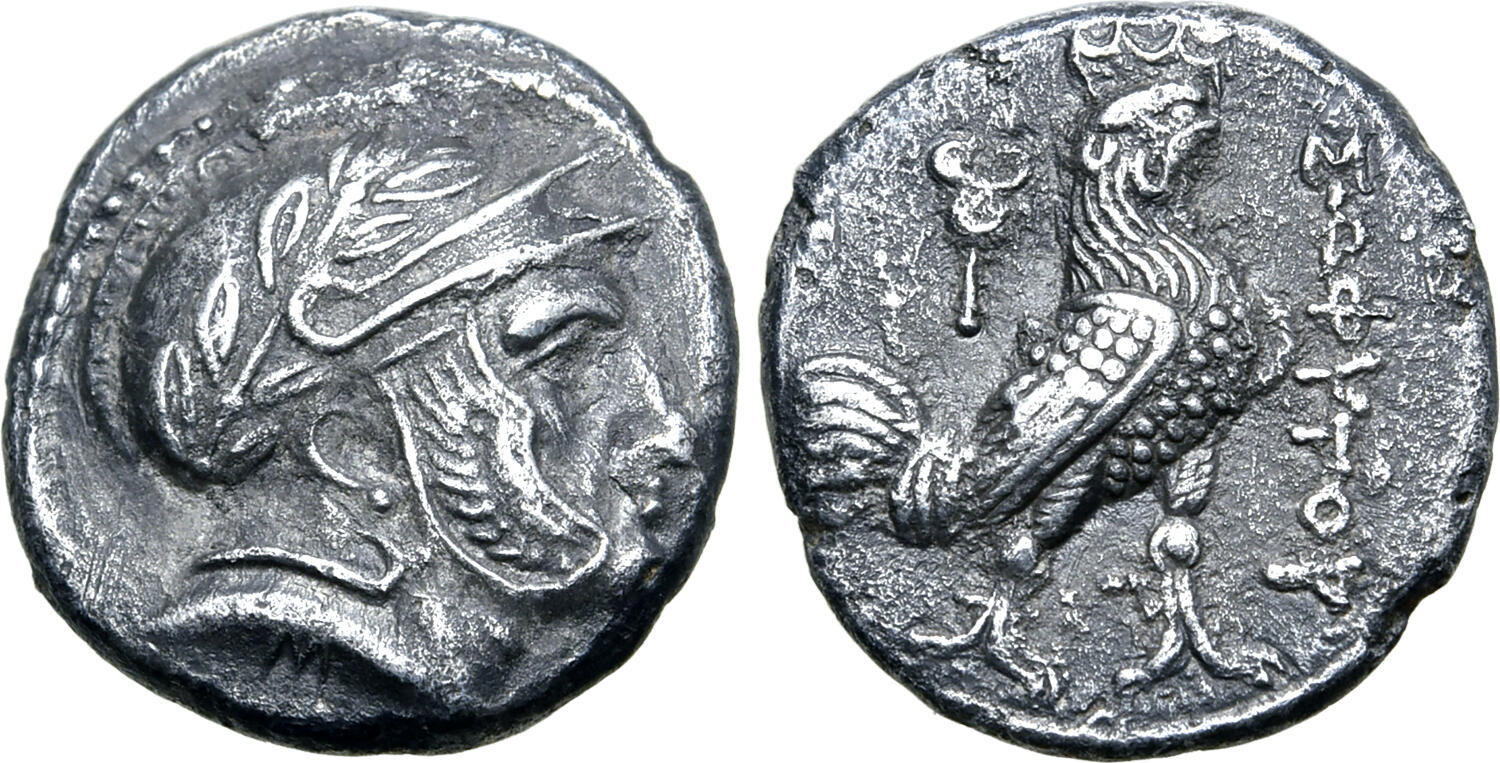S 1905 - Oxus (uncertain mint) (Sophytes), silver, drachms (246-235 BCE)
From SILVER
246 BCE - 235 BCE Silver 4,566 kg
Description
| ObverseInscription or printing placed on the obverse.: | Head of Seleukos(?) to right, wearing laurel wreathed Attic helmet decorated with spiral pattern on crest and eagle wings on cheek-guard, M on bust truncation |
| ReverseInscription or printing placed on the reverse.: | ΣΩΦYΤΟΥ to right (Greek).Cockerel standing to right, kerykeion behind |
Mint and issuing power
| MintIdentifies the place of manufacture or issue of a numismatic object.: | Oxus (uncertain mint) | Ancient regionAncient region.: | Bactria | Modern countryModern country: Afghanistan | AuthorityIdentifies the issuing power. The authority can be "pretended" when the name or the portrait of X is on the coin but he/she was not the issuing power. It can also be "uncertain" when there is no mention of X on the coin but he/she was the issuing power according to the historical sources: | Sophytes, Bactrian Kingdom |
Chronology
| FromIdentifies the initial date in a range assigned in a numismatic context. | 246 BCE | toIdentifies the final date in a range assigned in a numismatic context.. | 235 BCE | PeriodTime period of the numismatic object.: Hellenistic 323-30 BC |
Physical description
| MetalThe physical material (usually metal) from which an object is made.: | Silver |
Median weightMedian of the weights of numismatic objects (in grams). in grams | 3.60 | DenominationTerm indicating the value of a numismatic object. Examples: tetradrachm, chalkous, denarius.: | drachma |
StandardStandard.: | Attic |
References
| Die study referencePublication of the study: | Jansari 20181Jansari 2018, p. 94-95 | ||
| Coin series referenceReference to coin series study: | HGC 122HGC 12, n° 14 | ||
Obverse dies distribution
| FrequencyFrequency of specimen in distribution. ᵖ | Number of obversesNumber of obverse dies. ᵖ (o) | % (o) | Number of coinsNumber of coins. (n) | % (n) | Die nameName(s) of the die(s). |
| 1 | 16 | 59.26 | 16 | 39.02 | 2, 11, 12, 14, 15, 16, 17, 19, 20, 21, 22, 23, 24, 25, 26, 27 |
| 2 | 8 | 29.63 | 16 | 39.02 | 3, 5, 6, 7, 9, 10, 13, 18 |
| 3 | 3 | 11.11 | 9 | 21.95 | 1, 4, 8 |
| Total | 27 of 27 | 100 | 41 of 41 | 99.99 |
Reverse dies distribution
no distribution is available
Quantification
| Number of obversesNumber of obverse dies. ᵖ (o) | 27 | Number of singletons (o1)The number of singleton coins. ᵖ | 16 |
| Number of reverse diesNumber of reverse dies. (r) | 34 | Number of coinsNumber of coins. (n) | 41 |
| Coins per obverse dieNumber of coins per obverse die. (n/o) | 1.52 | Coins per reverse dieNumber of coins per reverse die. (n/r) | 1.21 |
| Reverse per obverse ratioRatio of obverse dies divided by reverse dies. (r/o) | 1.26 | Percentage of singletons (o1)number of coins (n) divided by the number of singletons (o1) ᵖ | 59.26 % |
| Original number of dies (O) (Carter 1983 formula)The estimation of the number of coins according to Carter 1983 ᵖ | 63.42 | Coins struck if 20,000 as average productivity per dieCoins made if the average productivity for obverses (according to Carter) is 20,000. ᵖ | 1,268,400 |
| Original number of dies (O) (Esty 2011 formula)The estimation of the number of coins according to the singleton formula in Esty 2011 ᵖ (O) | 79.07 | Survival rate if 20,000 as average productivity per dieSurvival rate if average productivity is 20,000. ᵖ | 0.00003 |
| Coverage (o = % of O) (Esty 1984 formula)Esty 1984 - coverage (% of O) ᵖ (o = % of O) | 60.98% | Die productivity if survival rate 1/2,000Average productivity if survival rate is 1/2,000. ᵖ | 1,292.97 |
| Weight of silver (in kg) if 20,000 coins per die (O = Carter formula)Carter 1983 * Median weight * 20000 (*10 if gold or electrum) ᵖ | 4,566 kg <br /> 4,566 kg | Die productivity if survival rate 1/5,000Average productivity if survival rate is 1/5,000. ᵖ | 3,232.42 |
Remarks
